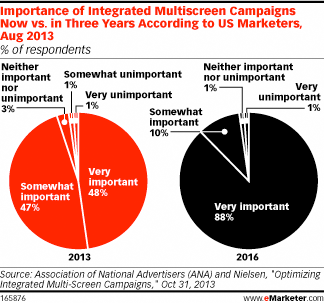Multiscreen Advertising, Audience Targeting lead the Way for Mobile Ad Targeting
March 11, 2014
![]() The best way to describe the state of mobile ad targeting is to say it’s a work in progress, according to a new eMarketer report, “Mobile Ad Targeting: After Years of ‘Spray and Pray,’ Signs of Sophistication Appear.”
The best way to describe the state of mobile ad targeting is to say it’s a work in progress, according to a new eMarketer report, “Mobile Ad Targeting: After Years of ‘Spray and Pray,’ Signs of Sophistication Appear.”
 Targeting ads to specific devices and operating systems is the most established form of mobile ad targeting. Trends that have been evident for several years continue to hold true while a new form of device targeting—multiscreen targeting—is emerging in response to consumers’ increased use of multiple web-enabled devices.
Targeting ads to specific devices and operating systems is the most established form of mobile ad targeting. Trends that have been evident for several years continue to hold true while a new form of device targeting—multiscreen targeting—is emerging in response to consumers’ increased use of multiple web-enabled devices.
With the smartphone- and tablet-using audiences growing rapidly—and time spent with media on these devices increasing steadily—marketers have started investing in multiscreen advertising campaigns. August 2013 polling by the Association of National Advertisers and Nielsen found that two-thirds of marketers spent up to 25% of their media budget on integrated multiscreen campaigns. By 2016, 72% of respondents expected this share to increase to between 26% and 100%. When asked to rate the importance of multiscreen advertising now and in the future, 48% said it was very important to their marketing efforts in 2013, and 88% expected it to be very important in 2016.
The unique and persistent account ID used by social networkers gives companies like Facebook and Twitter a big advantage in audience targeting compared with other mobile display ad providers. Regardless of the device a person chooses to log in from, a social network is able to recognize the ID and target ads based on the personal profile and behaviors associated with that ID.
Social networks aren’t the only ones with user account information and login IDs. Other digital giants, like Google, Amazon and eBay, as well as some premium publishers, retailers and app developers, have a large number of consumers logging in to their sites and services via mobile. The first-party user data available through those login IDs enables more sophisticated audience targeting capabilities.
Much like the desktop world, audience insights can be gleaned from the type of content consumed on smartphones and tablets. Those insights can then be used to build targetable audience profiles. For example, Flurry segments consumers using apps on its analytics platform into roughly 40 targetable personas. Consumers within each segment share interests in certain apps and exhibit similar usage patterns.
Courtesy of eMarketer




























